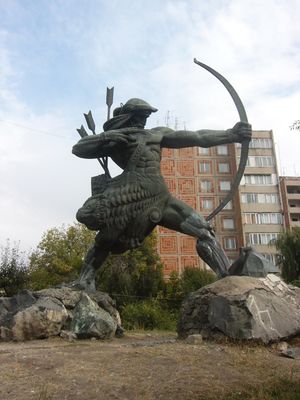هايك
هايك الأكبر (بالأرمينية: Հայկ)؛ النُطق الأرمني: [hajk]، إنگليزية: Hayk the Great، ويُعرف أيضاً بإسم هايك ناهاپت (Հայկ Նահապետ, النُطق الأرمني: [hajk nahapɛt]، هايك "رأس العائلة" أو البطريرك[1]), هو الأب الأسطوري ومؤسس الأمة الأرمنية. قصته موجودة في تاريخ أرمينيا المنسوب إلى المؤرخ الأرمني موسى من خورين (410 إلى 490).
. . . . . . . . . . . . . . . . . . . . . . . . . . . . . . . . . . . . . . . . . . . . . . . . . . . . . . . . . . . . . . . . . . . . . . . . . . . . . . . . . . . . . . . . . . . . . . . . . . . . . . . . . . . . . . . . . . . . . . . . . . . . . . . . . . . . . . . . . . . . . . . . . . . . . . . . . . . . . . . . . . . . . . . .
أصل الكلمة
اسم البطريرك، Հայկ هايك is not exactly homophonous with the name for "Armenia", Հայք Hayk’. Հայք Hayk’ is the nominative plural in Classical Armenian of հայ (hay), the Armenian term for "Armenian."[2] Some claim that the etymology of Hayk' (Հայք) from Hayk (Հայկ) is impossible[2] and that the origin of the term Hay ("Armenian") is verifiable.[2] Nevertheless, Hayk and Haig are usuallyقالب:How connected to hay (հայ) and hayer (հայեր, the nominative plural in Modern Armenian), the self-designation of the Armenians. Armen Petroyan believes that the name Hayk can "very plausibly" be derived from the Indo-European *poti- ‘master, lord, master of the house, husband’.[3]
Hayk would then be an etiological founding figure, like e.g. Asshur for the Assyrians, etc. One of Hayk's most famous scions, Aram, settled in Eastern Armenia from the Mitanni kingdom (Western Armenia), when Sargon II mentions a king of part of Armenia who bore the (Armenian-Indo-Iranian) name Bagatadi ("Theodore").[4]
Armenian historiography of the Soviet era connected Hayk with Hayasa, mentioned in Hittite inscriptions.[5]
The Armenian word haykakan or haigagan (بالأرمينية: հայկական, meaning "that which pertains to Armenians") finds its stem in this progenitor.
الفولكلور
هايك والملك بعل
معركة العمالقة وهزيمة بعل
Hayk and his men soon discovered Bel's army positioned in a mountain pass (Moses of Chorene located the site as Dastakert), with the king in the vanguard.
أساطير مقارنة
The figure slain by Hayk's arrow is variously given as بعل أو نمرود. Hayk is also the name of the Orion constellation in the Armenian translation of the Bible. Hayk's flight from Babylon and his eventual defeat of Bel, was historically compared to Zeus's escape to the Caucasus and eventual defeat of the Titans.[6]
انظر أيضاً
الهامش
- ^ Gōsh, Mkhitʻar (2000). The Lawcode (Datastanagirk') of Mxit'ar Goš. Rodopi. p. 112. ISBN 9789042007901. Retrieved 6 July 2016.
- ^ أ ب ت Moses of Khoren; Thomson, Robert W. (1978). "Genealogy of Greater Armenia". History of the Armenians. Cambridge, Massachusetts: Harvard University Press. p. 88. ISBN 0-674-39571-9.
{{cite book}}: Cite has empty unknown parameter:|coauthors=(help) - ^ Petrosyan, Armen (2009). "Forefather Hayk in the Light of Comparative Mythology". Journal of Indo-European Studies. 37: 155–163.
- ^ International Standard Bible Encyclopedia; the ISBE uses the outdated terms "Aryan" for "Indo-European".
- ^ Eduard L. Danielian, "The Historical Background to the Armenian State Political Doctrine," 279–286 in Nicholas Wade, Armenian Perspectives (Surrey, UK, 1997) 279, citing E. Forrer, "Hajassa-Azzi," Caucasia, 9 (1931), and P. Kretschmer, "Der nationale Name der Armenier Haik," Anzeiger der Acad. der Wiss. in Wien, phil.-his. Klasse (1932), n. 1–7
- ^ Vahan Kurkjian, "History of Armenia," Michigan, 1968
المصادر
- P. Kretschmer. "Der nationale Name der Armenier Haik"
- Vahan Kurkjian, "History of Armenia", Michigan, 1968
